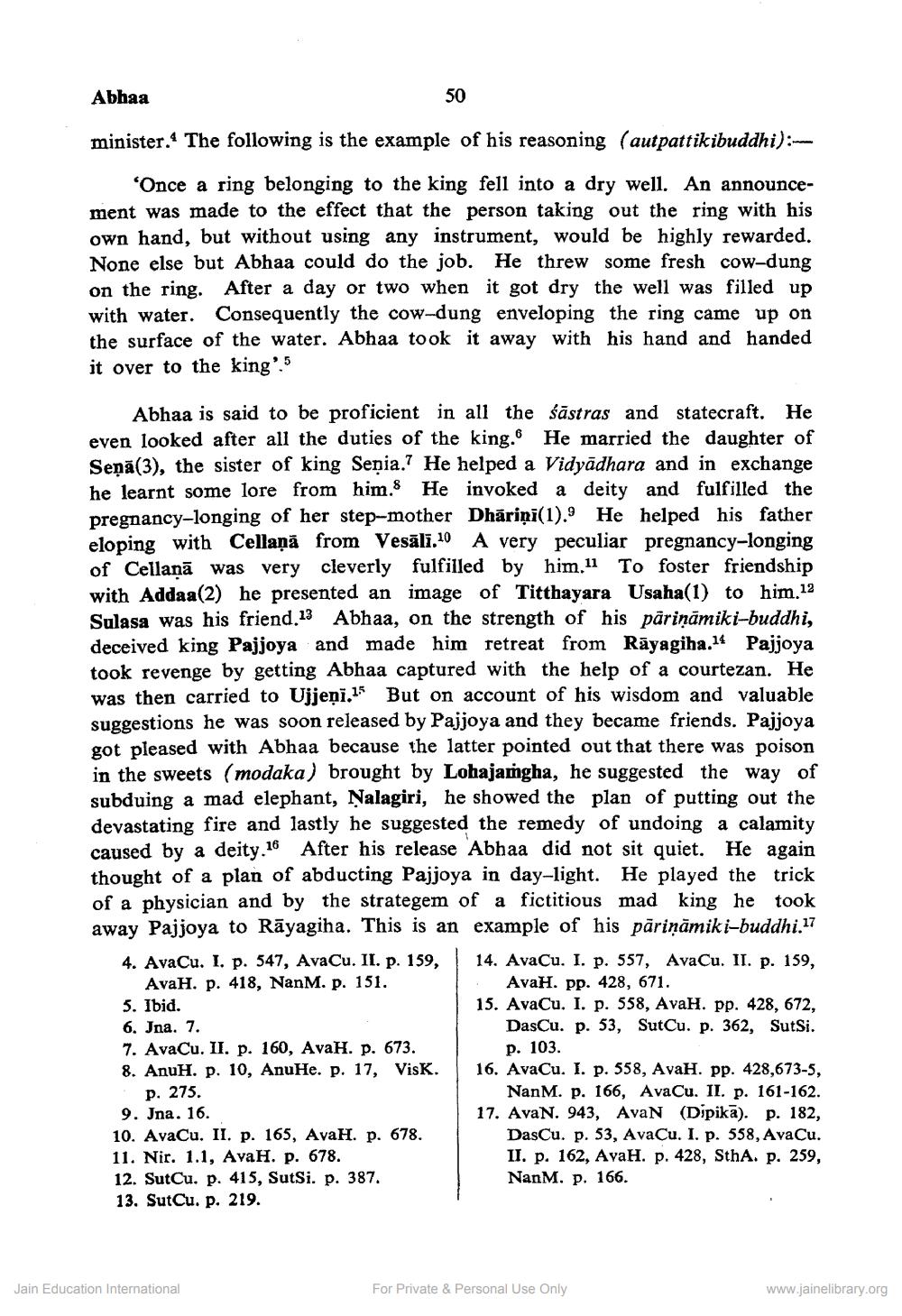________________
Abhaa
50
minister. The following is the example of his reasoning (autpattikibuddhi):
'Once a ring belonging to the king fell into a dry well. An announcement was made to the effect that the person taking out the ring with his own hand, but without using any instrument, would be highly rewarded. None else but Abhaa could do the job. He threw some fresh cow-dung on the ring. After a day or two when it got dry the well was filled up with water. Consequently the cow-dung enveloping the ring came up on the surface of the water. Abhaa took it away with his hand and handed it over to the king's
Abhaa is said to be proficient in all the śāstras and statecraft. He even looked after all the duties of the king. He married the daughter of Senā(3), the sister of king Senia.? He helped a Vidyādhara and in exchange he learnt some lore from him. He invoked a deity and fulfilled the pregnancy-longing of her step-mother Dhāriņi(1).9 He helped his father eloping with Cellaņā from Vesālī.10 A very peculiar pregnancy-longing of Cellanā was very cleverly fulfilled by him.11 To foster friendship with Addaa(2) he presented an image of Titthayara Usaha(1) to him.12 Sulasa was his friend.13 Abhaa, on the strength of his pāriņāmiki-buddhi, deceived king Pajjoya and made him retreat from Rāyagiha.14 Pajjoya took revenge by getting Abhaa captured with the help of a courtezan. He was then carried to Ujjeņi.15 But on account of his wisdom and valuable suggestions he was soon released by Pajjoya and they became friends. Pajjoya got pleased with Abhaa because the latter pointed out that there was poison in the sweets (modaka) brought by Lohajamgha, he suggested the way of subduing a mad elephant, Ņalagiri, he showed the plan of putting out the devastating fire and lastly he suggested the remedy of undoing a calamity caused by a deity.16 After his release Abhaa did not sit quiet. He again thought of a plan of abducting Pajjoya in day-light. He played the trick of a physician and by the strategem of a fictitious mad king he took away Pajjoya to Rāyagiha. This is an example of his pāriņāmiki-buddhi.17 4. AvaCu. I. p. 547, AvaCu. II. p. 159, 14. Avaču. I. p. 557, AvaCu. II. p. 159, AvaH. p. 418, NanM. p. 151.
AvaH. pp. 428, 671. 5. Ibid.
15. AvaCu. I. p. 558, AvaH. pp. 428, 672, 6. Jna. 7.
DasCu. p. 53, SutCu. p. 362, SutSi. 7. AvaCu. II. p. 160, Aval. p. 673.
p. 103. 8. Anuh. p. 10, AnuHe. p. 17, VisK. 16. AvaCu. I. p. 558, AvaH. pp. 428,673-5, p. 275.
NanM. p. 166, AvaCu. II. p. 161-162. 9. Jna. 16.
17. AvaN. 943, AvaN (Dipikā). p. 182, 10. AvaCu. II. p. 165, AvaH. p. 678. DasCu. p. 53, AvaCu. I. p. 558, AvaCu. 11. Nir. 1.1, AvaH. p. 678.
II. p. 162, AvaH. p. 428, SthA. p. 259, 12. SutCu. p. 415, SutSi. p. 387.
NanM. p. 166. 13. SutCu. p. 219.
Jain Education International
For Private & Personal Use Only
www.jainelibrary.org




